Cuisine of Quebec
Québec's cuisine is a rich national cuisine with many regional specialties. It is descended from 16th-century French cuisine and heavily influenced by the province's history of fur trading and hunting. It has also been influenced by learnings from First Nations, by English cuisine, by American cuisine, and, recently, by immigrant cuisines.

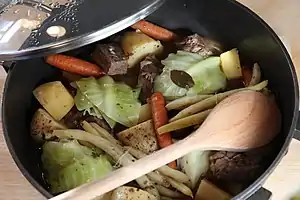
Since the 16th century, the labour-intensive nature of colonial life and the need to conserve resources have driven French-descended inhabitants of North America to create a new cuisine. Many ingredients were rare or seasonal. The cuisines of the people of New France and Acadia have much in common. Acadian food, however, is slightly more focused on seafood because of that province's maritime history. Since the 1970s, more and more unique dishes have been developed in various regions of Québec.
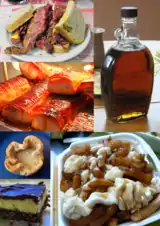 |
| Part of a series on |
| Canadian cuisine |
|---|
|
Traditional Québécois cuisine takes the place of honour during le temps des sucres, a period in March when families visit sugar shacks), as well as le temps des fêtes, the time from mid-December to early January covering the holidays and observations of Christmas Eve, Réveillon, Midnight Mass, Christmas, le lendemain de Noël (Boxing Day), New Year's Eve, New Years, and Epiphany.
Food critic Jacob Richler wrote that Québécois cuisine is better defined than that of Canada as a whole, due to its language barrier with the dominant culture of the United States and having had more time to develop.
History
The cuisine of Québec evolved from that of 16th-century Northern France. It also retains some heritage from Poitevin cuisine: many Québecois make pâté marmite; soupe aux gourganes, which is based on gourgane beans, a strain of fava bean[1]; and soups based on other legumes.[2] Furthermore, Charentaise chowders (chaudrées charentaises) have evolved into the quiaudes of Gaspesia[3] and the tourtes salées of Poitiers into tourtières.[4][5] Other foods that originate from France are pot-au-feu; blood sausage (boudin); head cheese (tête fromagée); plorine sausages; ham hock stew (ragoût de pattes de cochon); rabbit stew (civet de lapin); French toast (pain perdu or pain doré); and pastries like crêpes, beignets, croquignole biscuits, and tarts. As in France, pork is the most popular meat.
_par_Edmond-Joseph_Massicotte.jpg.webp)
From the moment they arrived in the early 1600s, French colonists preferred their native cuisine. However, they learned some culinary techniques from the Atikamekw, Algonquins, and Iroquois. The most important ones were l’acériculture (the process of harvesting maple sap and creating maple syrup), ice fishing, and boucanage (in which fish or other meat is smoked for preservation and flavour). Food preservation was always important in pioneer times, due to long winters and to the frequent voyages of coureurs des bois. Therefore, butter, herbs, and lard were used for seasoning and salting. Pork and fish were boucanés, while other meats and vegetables were preserved in vinegar. These techniques are still practiced today, though not for survival. Pioneers and their descendants also hunted and fished for sustenance.
By the 1670s, a substantial agrarian population had emerged in the region of Québec City, and French habits dominated. Meals would almost always feature soup, bread, meat, and wine.[6] Since the climate made it difficult to grow grapes, wines were always imported from France.[7]
The Conquest of New France in 1760 brought some culinary changes to Québec. One of the immediate effects was the elimination of wine, as it could no longer be imported from France. Another major change was the importation of the potato, which, in only a few decades, became a staple ingredient in Québec, dethroning the once all-encompassing bread in popularity. Sugar consumption also increased. Finally, the British imported many recipes like mashed potatoes, crumble, and meat pies.
.jpg.webp)
The period following the Aroostook War in 1839 resulted in increased interaction between Québéc and New England. Some recipes inspired by the cultural exchange included fèves au lard, homemade ketchup, and date squares.[8] In this period, the socio-economic standing of French Canadians fell to deplorable levels; the intense poverty pushed them to simplify their meals. Recipes for bouillon were now almost nothing more than warm water. Alcoholic beverages were rarely consumed, and butter was either used sparingly or absent. Some famine foods like ploye emerged during this period.
By the early 1900s, conditions had improved somewhat, though French Canadians were still poor. Most families would often eat a mix of potatoes and pork on their plate, which is still a staple combination today. During this period, the passenger pigeon, called tourte in French, also became extinct. Because this bird's meat had been used to fill the pie-like pastries known as tourtières, the tourtière recipe had to change. Mostly, farm-raised meats like beef and pork were used as the substitutes.
The Great Depression of the 1930s saw the creation of new recipes like pâté chinois (literally "Chinese pie") and pouding chômeur (literally "unemployed man's pudding") that were delicious and cost-conscious. Immigration after this period diversified; immigrants no longer came only from the British Isles but also from other parts of Europe. Jewish specialties like bagels and Eastern Europe-style smoked meat became popular, resulting in the creation of Montreal-style smoked meat and Montreal-style bagels.
The 1950s saw many changes in the eating habits of the Québécois, for a variety of reasons. Many American fast food companies and restaurants expanded in Québec, raw milk was banned, many fruits and vegetables became available throughout the year, and Québécois no longer needed to hunt and fish for sustenance. As a result, the pain de ménage (literally "household bread"), the traditional Québécois bread, was replaced with pain à sandwich; many old cheese recipes were abandoned and new ones created; and spaghetti, pizza, turkey, bacon, [[sausage]s], industrial cheeses, hamburgers, hot dogs, french fries, coleslaw, lobster rolls, and hot chicken all become popular. These changes brought about the creation of poutine, the most famous Québécois dish, in the late 1950s, as well as other dishes.
The Quiet Revolution of the 1960s greatly improved the socio-economic standing of French Canadians, allowing them to have a more diverse diet and setting the stage for high-quality products to be created in Québec.
From the 1970s to today, the various regions of Québec have been developing unique regional dishes as well as unique products like ice cider and native varieties of wine and cheese. Mass immigration from Europe has also given rise to a preference for more-refined culinary habits and creations, further promoting the creation and production of unique high-quality cheeses and alcoholic beverages across Québec and a return to recipes of the terroir. Finally, mass immigration from elsewhere has resulted in ethnic communities of Greeks, Chinese, and other peoples opening restaurants dedicated to their cuisines. Sometimes these culinary traditions are combined with Québécois cuisine.
Ingredients
Game, seafood, and fish
Historical poverty led many families in Québec to hunt in order to feed themselves until the 1950s. Tourtières, as noted above, were historically stuffed with the meat of the tourte, or passenger pigeon, which was common and easy prey for early Québécois. It is said that they flew in such large flocks, a hunter needed only to point his gun upward to bring one down. But, by the early 1900s, the passenger pigeon became extinct due to overhunting, deforestation, and the Allee effect. Subsequently, families instead used whatever meat they had on hand, usually from livestock. As a result, most modern tourtières are filled with beef or pork. Today, the consumption of game remains a tradition, although game is not sold in grocery stores. When available, Québécois eat meat from moose, deer, hares, ruffed grouse, or waterfowl rather than that of livestock. Game is also sometimes given as a gift.
As for seafood, lobster and crab are caught in Gaspesia, la Côte-Nord, and the Magdalen Islands to be sold to the rest of Québec. Shrimp is often marketed as crevette de Matane after the shrimp-processing factory in the town of Matane. However, the shrimp themselves are caught in several villages on the Saint Lawrence River estuary. Mussels, oysters, scallops, and whelks (bourgots) are also caught.[9]
Salmon and trout are the most popular fish in Québec. The brook trout is nearly ubiquitous, salmon is farmed and can be caught in 118 different rivers, and Arctic char is present across nearly 100 lakes.[10] Other fished species include lake trout, yellow perch, ouananiche (a kind of freshwater salmon; Lac Saint-Jean), frostfish (Sainte-Anne-de-la-Pérade), deepwater redfish (Saguenay fjords), capelin (coastal villages), brown bullhead (Îles de Sorel), American eel (between Trois-Rivières and Cap-Chat), Atlantic cod (Eastern Québec), Atlantic herring (Eastern Québec), walleye, muskellunge, Northern pike, micropterus, rainbow smelt, Greenland halibut, mackerel, lake sturgeon, and lake whitefish. Sainte-Anne-de-la-Pérade holds a world-renowned festival every December to February called La pêche des petits poisons des chenaux, where ice fishers catch tomcods. Historically, starving French colonists learned ice fishing from the Atikamekw — a privilege, as the technique was kept a secret from neighbouring First Nations.
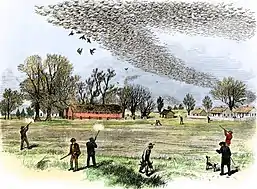


Livestock
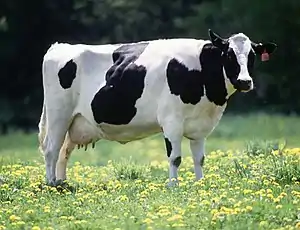
Pork is the meat used most often in Québécois recipes. Beef is also commonly used but has been losing popularity in recent years. In summer, beef commonly features in barbecues. While horse meat is consumed marginally, Québec is still the place in North America where it is most commonly eaten.[11]
Québécois pigs are mostly hybrids of the duroc, Yorkshire, and American Landrace breeds.[12] The cattle are also hybrids of many breeds; the Angus, Charolais, and Limousin are the most common.[13] Despite the large cattle population, Québec imports most of its beef from the Canadian West, using its own cattle mostly for dairy. Milk production is dominated by the Holstein, but Jersey or Brown Swiss cows are also milked.[14] The Canadienne is an ancestral breed of Québécois cattle that was once widely raised in the province. There are still a few hundred of these cows left in the Charlevoix and Magdalen Islands regions. Their milk is used in artisanal cheeses.
Poultry is very commonly consumed in Québec. The most popular types are chicken and turkey.[15] The ancestral Chantecler chicken, developed in Oka the early 1900s, is now on the market once again.[16] Turkey is traditionally served at Christmas and Thanksgiving with croutons and sage.[17] Chicken eggs are very popular and mostly used at breakfast and to make pastries. The Estrie region has produced duck since the early 1900s. Québec is also the only producer of foie gras in Canada, as well as its largest producer in North America.[18]
Other meats include lamb, veal, and frog legs (from American bullfrogs and leopard frogs).[19]
Spices, vegetables, and fruits
Québécois cook with butter. Salt can replace or be combined with herbs for seasoning. Spices common in traditional recipes are linked to local production and historical commerce: savory, cloves, cinnamon, parsley, thyme, sage, nutmeg, quatres épices, and bay leaf. In recent years, spices with provenance in the boreal forest have appeared on Québécois tables, among them green alder pepper (poivre des dunes or poivre d'aulne), sweetfern (comptonie voyageuse), caraway seed (carvi sauvage), sweetgale, and juniper berry. Chefs create interest in and excitement for these new flavours in cooking. Maple syrup is used to sweeten breakfasts, meats, and pastries. Traditional grains are wheat and buckwheat; their flours are used in sauces and ragoûts.[20] Buckwheat became popular because it could grow well on the Canadian Shield.
The most commonly used vegetables in traditional Québécois cuisine were those that can easily be preserved to last throughout the winter, either kept in a cool storage area like a root cellar or brined in jars. These vegetables are the potato, onion, carrot, beet, squash, legumes, cabbage, turnip, and corn. Today, Québécois also cook with the tomato, bell pepper, cucumber, lettuce, asparagus, cauliflower, broccoli, and other newer vegetables. Rhubarb, fiddleheads, and chives are consumed seasonally. Rhubarb and chives are often grown in backyard gardens, while fiddleheads are gathered in the wild.
The most popular berries are the blueberry, strawberry, raspberry, cherry, cranberry,[21] cassis, and cloudberry.[22][23] They are used in jams and jellies, spreads, gelées, desserts, juices, and alcoholic beverages. Blackcurrants and blue honeysuckle have recently entered Québécois markets. Other important fruits are the apple, pear, and plum.[24][25][26] Apples are especially important because they are used to make cider and are the star of le temps des pommes. Imported citrus fruits and tropical fruits are also often enjoyed today. In the past, however, they were so expensive they would be bought only for special events or as a gift. It was customary to give children an orange for Christmas.
Mushrooms have long been absent from Québec's traditional cuisine and culinary history. Today, when mushrooms are used, they are usually of the cremini variety. In recent years, devoted cooks have introduced indigenous species into their culinary creations. Morchella and chanterelle mushrooms are gaining more and more popularity as a result.[27]
Finally, some ingredients like rice, molasses, raisins, and brown sugar appear in traditional Québécois recipes because of historical commerce between New France and regions like the Antilles and Brazil.


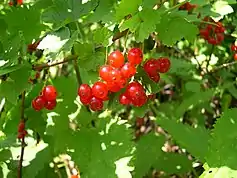
Famous Dishes
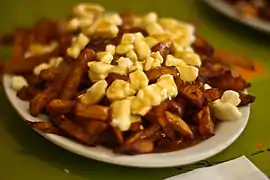
Québec is most famous for its poutine, tourtières, pâté chinois, pea soup, fèves au lard (beans baked in lard; similar to Boston baked beans), cretons (a forcemeat-style pork spread containing onions and spices, similar to French rillettes), and desserts such as maple syrup-based grand-pères, pouding chômeur, and St. Catherine's taffy (tire Ste-Catherine). Spruce beer is also a traditional beverage.
The sugar season (le temps des sucres) is one of the oldest Québécois culinary traditions. In early spring, many Québécois visit sugar shacks (cabanes à sucre) for a traditional meal of eggs, baked beans, ham, oreilles de crisse, and bacon, all of which they then cover in maple syrup. Associated activities are a horse-drawn sleigh ride in the woods and sugar on snow (tire sur la neige) — boiled maple tree sap dribbled over snow, which then hardens and is eaten as a treat.
Many traditional dishes are intrinsic to holidays. Réveillon, the Christmas Eve (or New Year's Eve) feast, usually features items like a bûche de Noël (Yule log) and tourtières.
Traditional Recipes






Entrées
- Consommé de légumes ou de bœuf (Vegetable or beef consommé)
- Cretons [28]
- Fondue au parmesan (Parmesan fondue) [29]
- Quiaude
- Soupe aux gourganes (Broad bean soup) [30]
- Soupe à l'orge perlé (Pearl barley soup) [31]
- Soupe aux pois (Pea soup) [32]
- Soupe à la poulette grasses (Fat chicken soup)[33]
Main course
- Bœuf bourguignon
- Bouilli de légumes (Vegetable bouillon)
- Chiard de porc[34]
- Cigares au chou (Cabbage cigars)
- Coquille Saint-Jacques [35]
- Feuilleté jambon-fromage (Ham and cheese feuilleté)
- Fèves au lard (Fatty beans)
- Galette aux patates (Potato pancake)
- Galette de sarrasin (Buckwheat pancake)
- Guédille
- Gibelotte de Sorel[36]
- Hot chicken [37]
- Jambon à l'érable (Maple ham)
- Macaroni chinois (Chinese macaroni)[38]
- Médaillons de cerf (Venison medallions)
- Pain au fromage (Cheese bread)
- Pain à viande/Rôti hâché (Meat bread)
- Pâté chinois (Chinese pâté)
- Pâté au poulet (Chicken pâté)
- Pâté au saumon (Salmon pâté)
- Pétoncles frites (Fried scallops)
- Pot-au-feu de la récolte (Pot-au-feu of the harvest)[39]
- Poulet chasseur [40]
- Poutine
- Poutine variant
- Ragoût de boulettes (Meatball ragoût)
- Ragoût de pattes de cochon (Pig feet ragoût)
- Rôti de porc (Pork rôti)
- Tête fromagée
- Tourtière
- Tourtière du Lac-Saint-Jean
- Vol-au-vent au poulet (Chicken vol-au-vent)
Desserts
- Beigne à l'ancienne (Old fashioned doughnuts)
- Beigne aux patates (Potato doughnuts)
- Bonbons aux patates (Potato candy)
- Bûche de Noël
- Carrés aux dattes (Date squares)
- Croustade aux pommes (Apple crumble)
- Gâteau aux bananes (Banana cake)
- Gâteau aux carottes, glaçage au fromage à la crème (Carrot cake, with cream cheese)
- Gâteau à l'érable (Maple cake)
- Galette à la mélasse (Molasses pancake)
- Gâteau Reine Élisabeth (Queen Elizabeth cake)[41]
- Gâteau au pain d'épices (Spice cake)
- Gâteau aux zucchinis (Zucchini cake)
- Grands-pères au sirop d'érable
- Pets de sœurs
- Pouding chomeur
- Pouding au pain (Bread pudding)
- Queue de castor (Beaver Tail)
- Sucre à la crème
- Tarte au beurre (Butter tarts)
- Tarte aux bleuets (Blueberry pie)
- Tarte à la ferlouche
- Tarte aux fraises et à la rhubarbe (Strawberry and rhubarb pie)
- Tarte aux pommes (Apple pie)
- Tarte au sirop d'érable (Maple syrup pie)
- Tarte au sucre (Sugar pie)
- Tarte au suif (Pork fat pie)[42]
- Tire de la Sainte-Catherine (St. Catherine's taffy)
- Tire sur neige (Sugar on snow)
- Trottoirs[43]
- Trou de beigne (Doughnut holes)
Sides
- Betteraves marinées (Pickled beets)[44]
- Ketchup maison rouge ou vert (Red or green homemade ketchup) [45]
- Langue de veau ou de porc (Pork or veal tongue)
- Navets et carottes en dés cuits macédoine (Diced radishes and carrots macédoine style)
- Oreilles de crisse [46]
- Pain sandwich - miche coupée à l'horizontale (Sandwich bread with miche cut sideways)
- Patates pilées et carottes (Mashed potatoes and carrots)
- Salade de chou (Cabbage salad)
- Salade de macaroni (Macaroni salad) [47]
- Salade verte avec crème fraiche (Green salad with fresh cream)
- Sandwich aux œufs (Egg sandwich)
Drinks
- Bière d'épinette (Spruce beer)
- Cidre glacé (Ice cider)
- Vin glacé (Ice wine)
- Caribou
Poutine
Poutine is the most famous Québécois dish. It is composed of fresh french fries and fresh cheese curds topped with hot brown gravy in a shallow bowl. The cheese curds are usually room temperature to prevent them from melting and losing their elasticity or "squeakiness". Poutine emerged in the Centre-du-Québec area in the late 1950s. Its precise origins are uncertain as there are several competing claims to having invented the dish.
For many years it was perceived negatively by English-speaking Canadians and mocked in English Canada. It was even used by some to stigmatize Quebec society. But, it later became celebrated as a symbol of Québécois culture and the province of Quebec. It has long been associated with Quebec cuisine, and its rise in prominence has led to its popularity in the rest of Canada, in the northern United States, and internationally. Poutine has been called "Canada's national dish" though many believe this represents cultural appropriation of Québécois and Quebec's national identity.
Many variations on the original recipe have been created over the years and some are very popular and recurrent. Poutine is now considered by many to be more than just a dish and, in fact, a dish class like sandwiches or dumplings. Here are the most common poutine variations: [48] [49]
| Image | Variant | Ingredients | Notes |
|---|---|---|---|
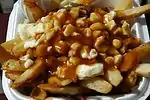 |
Classic/ Québécois | Fries, cheese curds, gravy | |
| All-dressed | Fries, cheese curds, gravy, bell pepper, ham, sausages, onions, pepperoni, mushrooms |
| |
| Bacon | Fries, cheese curds, gravy, bacon | ||
| BBQ | Fries, cheese curds, BBQ sauce |
| |
 |
Breakfast | Fries, cheese curds, hollandaise sauce |
|
| Chicken | Fries, cheese curds, gravy, chicken | ||
 |
Foie gras | Fries, cheese curds, gravy, foie gras |
|
 |
Fried clam | Fries, cheese curds, gravy, fried clams |
|
.jpg.webp) |
Galvaude | Fries, cheese curds, gravy, turkey, green peas |
|
| Italian | Fries, cheese curds, bolognese sauce | ||
| Lobster | Fries, cheese curds, sauce (variable type), lobster, chives |
| |
| Mac & Cheese | Fries, cheese curds, mac & cheese, chives |
| |
| Mushroom | Fries, cheese curds, gravy, mushrooms |
| |
| Nacho/ Mexican | Fries, cheese curds, gravy, sour cream, guacamole, tomatoes, cilantro |
| |
| Onion ring | Fries, cheese curds, gravy, onion rings | ||
| Pulled pork | Fries, cheese curds, gravy, pulled pork |
| |
| Shredded cheese | Fries, shredded cheese, gravy |
| |
| Smoked meat | Fries, cheese curds, gravy, smoked meat |
| |
| Steak | Fries, cheese curds, gravy, steak | ||
| Sweet potato | Sweet potato fries, cheese curds, gravy, chives | ||
 |
Thanksgiving/ Holiday | Fries, cheese curds, gravy, turkey, stuffing, cranberry sauce |
|
| Vegetarian | Fries, cheese curds, gravy, mushrooms, onions, bell peppers | ||
 |
Western/ Hot-dog | Fries, cheese curds, gravy, hot-dogs |
|
Unique Products
Cheeses
When Canada was part of the French Empire, colonials used their Canadienne cattle to create a variety of soft, semi-soft and soft-ripened cheeses to eat.[50] Following the Conquest of New France, the British began importing hard cheeses like cheddar that the population could also consume. In the 1960s, the banning of crude milk made most of the old cheese-making techniques and recipes, which up to that point had been successfully passed on for centuries, disappear and become forgotten. Only a few recipes remain. The Saint-Pierre, produced on l'île d’Orléans, has the honour of being the oldest North American cheese. It is a soft-ripened cheese sold under the forms of la Faisselle, le Paillasson or le Raffiné.[51][52][53] The Cailles cheese, a cheese made from fermented milk and typically used in salads, also used to be quite widespread. It now only exists in the Charlevoix and Saguenay-Lac-Saint-Jean regions. Nowadays, there are attempts to diversify the ways in which Cailles is consumed.[54] There are some cheeses that were also created by priests. Towards the end of the 19th century, a group of trappist monks were expulsed from France and moved to Oka. One of them, who originated from Notre-Dame-du-Port-du-Salut, created a semi-ferm paste which was eventually used to mold the first Oka cheese. Benedictines were responsible for creating l’Ermite, a blue cheese, in 1943 at Saint-Benoît-du-Lac.[55]
Today, Quebec creates over 700 different kinds of cheeses and is the biggest cheese producer in Canada.[56] Quebecers enjoy many natively produced and imported hard cheeses, including hard cheeses parfumed by beer or wine. Most soft cheeses are produced locally and many are artisanal. Cheese curds are notably used in poutine, one of the most famous Québécois dishes.

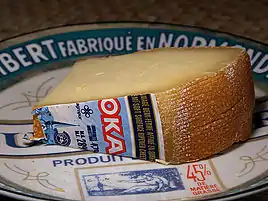

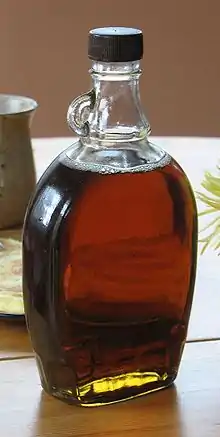
Maple syrup
Quebec produces 72% of the maple syrup sold on Planet Earth and 90% of the maple syrup sold in Canada.[57] Maple syrup is a sugary concoction made from heated maple sap. The syrup is often used at breakfast to cover crêpes and pain doré, and as a component of fèves au lard. It can also be used to caramalize meats like ham, to stabilize the acidity of certain sauces and as a side for deserts like with pouding-chômeur or Grands-pères au sirop d'érable. Finally, it is the main ingredient showcased during "le temps des sucres" and in sugar shacks.
Many maple syrup derived products exist. Tire, French for sugar on snow, is heated maple syrup that is cast onto a flat bed of snow and then rolled up onto a popsickle stick to be eaten like candy. Tire is very popular at sugar shacks and during springtime. Maple butter is a spread commonly used at breakfast on toast. Maple sugar can serve as a replacement to brown and white sugar. Maple water is not often consumed, but when it is, it is most often because it is believed to have health benefits.[58] Finally, there exists a variety of maple-flavoured products like maple-flavoured candy and maple-flavoured drinks.
Boucanage
In Quebec, the process of smoking meat is called "boucanage". It was learned by French Canadian colonials from Native Americans. While Native Americans only smoked, colonials would brine or spice before smoking. Today, establishments called "boucanières" or "boucaneries" are specialized in this process. On top of brining and spicing, boucanières can use tree essences to infuse a certain taste in the meat with maple wood being the most popular choice. Fish can also be dried before being suspended over a fire, something called "boucaner à froid".
This practice has always been popular, especially in the Gaspesia, Bas-Saint-Laurent and Côte-Nord regions. There, it was useful in order to preserve fish. Atlantic herrings were historically caught and exported in large quantities, so they were the most boucané. Though, trout and salmon caught inland were also commonly boucané.[59] Smoked salmon specifically has become more popular in recent decades due to influence from the United States and Europe. Pork also used to be boucané, but the popularity of smoked pork has decreased. Smoked pork is now almost exclusively consumed during Easter where it is sometimes boiled beforehand with its bones.
In the 1930s, Jewish immigrants came to Montreal and implanted some meat smoking traditions from Eastern Europe. The technique used implicates the smoking of beef that was brined with Montreal Steak Spice. After the meat is smoked, it is cut up in narrow slices. The meat is often served as part of a sandwich with mustard and rye bread.[60]


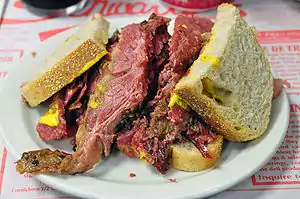
Pork
Pork-based charcuterie is traditionally referred to in Quebec as "cochonailles". Here are the most popular:
- Creton is composed of ground pork, lard (animal fat), milk and cereal that is cooked and flavoured together in order to obtain a creamy paste. Cretons are often eaten as a snack or breakfast on roasted bread pieces called rôties, along with mustard. If another kind of meat is used to create cretons, like poultry or veal, it is called cretonnade instead.
- Tête fromagée is less popular but used in the same way as cretons.
- The boudin of Quebec is made of lard (animal fat), milk, onions and pork blood. It is often served in a pan along with a sweet side or a sauce. Since 2018, the Goûte-Boudin de Boucherville association hands out a yearly prize for the best boudin.[61]
- Plorines (also written as pleurine or plârine) are composed of lard and flavoured meat enveloped in pork caul fat. Sometimes plorine recipes can also include eggs, beef and/or mie de pain (the inside part of the bread).
- Oreilles de Christ are lard pieces that are fried until they become crispy. They are eaten as an amuse-gueule and/or with maple syrup.
Pastries
A great variety of pastries are produced in Quebec. Here are some examples:
- Crêpes are flat round dishes made from wheat or buckwheat flour. The crêpes of Quebec are thicker than ones from France, but not thick like the pancakes of Anglo-Saxon cultures. They are popular breakfast items. They are often served with maple syrup, brown sugar and/or fruits. They can also be served during lunch or supper.
- Beignes, which resemble old-fashioned doughnuts, are dough rings that were fried in oil. The middle part of the dough is removed in order to create the ring, and these middle spheres are then cooked as well and consumed as trou de beigne (doughnuts holes). Powdered sugar or icing is often added on top of these pastries.
- Croquignoles are braided, twisted or rectangular fried dough pastries. They are a little less popular than beignes and can most often be found in rural regions.
- Pain doré consists of bread dipped a mix of scrambled eggs, milk, sugar and cinnamon before being cooked in a pan. It is served at breakfast covered with maple syrup.
- Tartes, similarly to pies, are composed of a shortcrust exterior and an interior spread. The most popular kinds of spread are fruit-based, like blueberry, apple, strawberry, raspberry, etc... Other popular kinds of tartes include tarte au sucre, with a mixed butter and brown sugar spread, tarte à la farlouche, with a mixed brown sugar, molasses and dried raisins spread, and tarte au suif which has beef fat as its spread.
- Sucre à la crème is a sugary snack composed of cream, brown sugar and butter. It can sometimes be found sold in convenience stores.
- Pets-de-sœur consist of a dough paste that is flattened and covered in a butter and brown sugar mix. The dough is then rolled over itself, cut to make a cylinder shape and then cut into thin slices.
- Chocolatines consist of small croissants with chocolate inside. They are sometimes sold in corner stores.
- Carrot cake with cream cheese icing is popular.
- Bûche de Noël is a wrapped cake pastry that is traditionally eaten during the Holidays.
- Pouding chomeur is a white cake soaked in maple syrup or brown sugar.
- Grands-pères are a cake in the shape of a sphere which is eaten plainly or covered with maple syrup. They can also sometimes be filled with fruits. They are sometimes served as part of meals as well.


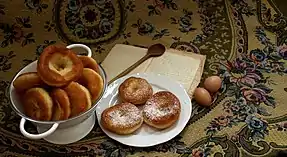
Regional Specialties
| Bas-Saint-Laurent | Cantons-de-l'Est | Centre-du-Québec |
Charlevoix
|
Duplessis | Gaspesia
|
Magdalen Islands |
Lanaudière
|
Manicouagan | Mauricie |
| Montérégie | Montréal | Nouveau-Québec (Nunavik)
|
| Outaouais | Québec | Saguenay–Lac-Saint-Jean
|
Strains and Breeds
Strains
.jpg.webp)

Over the centuries, varieties of fruits and vegetables were created in Quebec. The need to cultivate Quebec's strains has evaporated in recent times, causing most varieties to become lost.[66] Here are some strains that have been saved or rediscovered:
Breeds
Though less numerous now, these breeds created in Quebec are still used today:
- Canadienne cattle
- Charlevoix lamb
- Chantecler chicken
Cuisine of Quebec in Media
Many TV shows are or were dedicated to the cuisine of Quebec including À la di Stasio, L'Effet Vézina, Le Cuisinier rebelle, Curieux Bégin, Les Chefs!, Et que ça saute and Ricardo among others. The Zeste TV channel was also specialised in Quebec's cuisine.
In literature, the publishing house Les Éditions Debeur and some magazines (ex. Ricardo, je Cuisine, Caribou, etc...) are dedicated to this subject.
On the internet, some specialized sites exist, like Recettes du Québec (recettes.qc.ca) and Zeste (zeste.ca), while others have a section for Quebec's cuisine, like Allrecipes (qc.allrecipes.ca) or Chef Cuisto (chefcuisto.com/cuisine/recettes-quebecoises/).
Gallery
 Ancestral bread oven of Quebec in Saint-Damien-de-Bellechasse.
Ancestral bread oven of Quebec in Saint-Damien-de-Bellechasse._03.jpg.webp) The Pikauba was created in 2005 in Hébertville.
The Pikauba was created in 2005 in Hébertville._02.jpg.webp)
 The Cendrillon won Best cheese in the world in the 2009 World Cheese Awards.
The Cendrillon won Best cheese in the world in the 2009 World Cheese Awards. Whippet cookies were first produced in Montreal.
Whippet cookies were first produced in Montreal. Apple orchard in Saint-Joseph-du-Lac for ice cider production.
Apple orchard in Saint-Joseph-du-Lac for ice cider production. Vegetable display in marché Jean-Talon.
Vegetable display in marché Jean-Talon..jpg.webp) Common Thanksgiving decoration items in Quebec.
Common Thanksgiving decoration items in Quebec. In Quebec, Pepsi is more popular than Coca-Cola.
In Quebec, Pepsi is more popular than Coca-Cola. L'Éplucheuse de patates by Charles Huot.
L'Éplucheuse de patates by Charles Huot.
References
- "Le pâté marmite à l'ancienne – Le farci Poitevin". lefarci-poitevin.fr. Retrieved 2020-04-06.
- "La soupe aux fèves". yves.huot-marchand.pagesperso-orange.fr. Retrieved 2020-04-06.
- "Quand Alma préparait sa "kiaude"" (PDF) (in French). July–October 2016. Retrieved 7 April 2020.
- "La tourtière poitevine au poulet". France Bleu (in French). 2015-08-27. Retrieved 2020-04-06.
- "tourtiere de paques". creonsaufildessaisons.e-monsite.com (in French). Retrieved 2020-04-06.
- "Alimentation | Musée virtuel de la Nouvelle France". Retrieved 2020-04-06.
- "De la qualité des vins en Nouvelle-France" (PDF) (in French). Winter 1992. Retrieved 7 April 2020.
- "Les carrés divers | Le Québec Cuisine". www.quebecuisine.ca. Retrieved 2020-04-07.
- "The bourgot snail" (consulted 2020-09-17)
- "Liste des rivières à saumon" (consulted 2020-11-01)
- "Manger de la viande chevaline, un tabou qui persiste" (consulted 2020-09-16)
- "Les principales races de porc au Québec" (consulted 2020-09-16)
- "Les races de bœuf au Québec" (consulted 2020-09-16)
- "La sacrée vache" (consulted 2020-09-16)
- "Le poulet au Québec" (consulted 2020-09-16)
- "The Chantecler chicken : a historic chicken" (consulted 2020-09-16)
- "Christmas Turkey" (consulted 2020-09-17)
- [Des produits Rougié made in Canada |url=https://www.reussir.fr/volailles/des-produits-rougie-made-canada "Une filière foie gras complète"] (consulted 2020-09-16)
- "CHASSE À LA GRENOUILLE ET AU OUAOUARON" (consulted 2020-09-28)
- "Épices et herbes de chez nous" (consulted 2020-09-17)
- "Au pays de la canneberge" (consulted 2020-09-16)
- "Cassis du Québec (Canada) : La petite baie à la grande Histoire" (consulted 2020-09-16)
- site=La Terre de Chez Nous "Le Québec, premier au pays en fruits et petits fruits" (consulted 2020-09-16)
- "Le temps des prunes" (consulted 2020-09-16)
- "Auto-Cueillette - Cultures – Poire" (consulted 2020-09-16)
- "La camerise, une saveur unique" (consulted 2020-09-16)
- "L'Opération morille" (consulted 2020-09-17)
- "Cretons" (consulted October 28th 2020)
- https://www.ricardocuisine.com/recettes/4177-fondue-parmesan-aux-trois-fromages "Fondue au parmesan" (consulted November 20th 2020)
- "Fava bean soup" (consulted October 28th 2020)
- "Pearl barley soup" (consulted October 28th 2020)
- "Pea soup" (consulted October 28th 2020)
- "Soupe à la poulette grasse", boblechef.com (consulted 22 april 2019).
- "Chiard de porc", www.recettes.qc.ca (consulted 23 april 2019).
- "Coquille Saint-Jacques (les meilleures)", www.ricardocuisine.com (consulted 9 January 2021).
- "Recette de gibelotte", www.festivalgibelotte.qc.ca (consulted 23 april 2019).
- "Hot chicken de survie", cuisinez.telequebec.tv (consulted 23 april 2019).
- "Macaroni chinois", www.recettes.qc.ca (consulted 23 april 2019).
- "Pot-au-feu de la récolte", www.lecourrierdusud.ca (consulted 23 april 2019).
- "Poulet chasseur"(consulted 2020-11-08)
- "Gâteau Reine Élisabeth", www.recettes.qc.ca (consulted 23 april 2019).
- "Recette traditionnelle de tarte au suif", www.gratuit.ca (consulted 23 april 2019).
- "Trottoirs aux fraises à ma façon", www.recettes.qc.ca (consulted 22 april 2019).
- "Betteraves marinées", www.recettes.qc.ca (consulted april 23rd 2019).
- "Homemade ketchup" (consulted October 28th 2020).
- "Oreilles de crisse" (consulted October 28th 2020).
- "Macaroni salad" (consulted October 28th 2020).
- "Poutines les plus connues" (consulted November 2020)
- "Poutine" (consulted November 2020)
- "Fromages d’ici" (consulted 2020-04-07)
- "Un fromage de plus de 125 ans" (consulted 2020-04-07)
- "Le fromage de l'Île d'Orléans est sauvé" (consulted 2020-04-07)
- "Les Fromages de l'île d'Orléans" (consulted 2020-04-07)
- "Le fromage en grains ou en crottes" (consulted 2020-04-07)
- "Cheeses of Quebec" (consulted 2020-04-07)
- "Le Québec est le plus grand producteur de fromage au Canada" (consulted 2020-04-07)
- «Producteurs et productrices acéricoles du Québec" (consulted 2020-04-14)
- "Maple water CBC" (consulted 2020-04-14)
- "Fumage du poisson au Québec" (consulted 2020-04-09)
- "History of Smoked Meat in Quebec" (consulted 2020-04-09)
- "Association Québécoise du Goûte-Boudin de Boucherville – Faire connaître le boudain" (consulted 2020-04-09)
- "Matane, destination gourmande de la crevette", www.tourisme-gaspesie.com (consulted 23 april 2019).
- Site officiel, canardsdulacbrome.com (consulted 23 april 2019).
- "Regain d'intérêt pour la viande de phoque", www.journaldemontreal.com (consulted 23 april 2019).
- "Pot-en-pot aux fruits de mer", www.recettes.qc.ca (consulted 22 april 2019).
- "Gardiens de semences". 2019-05-13. Retrieved 2020-09-16.
- "Le maïs canadien blanc". Retrieved 2020-10-29.
- "La patate crotte-d'ours de Louis-Marie". Retrieved 2020-10-29.
- "The Thibodeau beans of Saint-Jules". Retrieved 2020-10-29.
- "La pomme Fameuse". Retrieved 2020-10-29.
- "Mémé tomato". Retrieved 2020-10-29.
- "The potato onion". Retrieved 2020-10-29.
Bibliography
- Anita Steward, Great Canadian Cuisine, Vancouver, Douglas & McIntyre, 1999, 192p.
- Cécile Roland Bouchard, L'Art culinaire au pays des bleuets et de la ouananiche, La Fondation culinaire régionale Saguenay-Lac-St-Jean, 1967, 245 p.
- Cercle de fermières de Cowansville, 100 recettes d'antan, Cowansville, Le Cercle, 1976, 112 p.
- Couillard, Suzette and Normand, Best Quebec Recipes of Bygone Days , L'Islet: Éditions Suzette Couillard, 2002, 367 p. (ISBN 978-2-920368-06-4).
- Émilienne Walker-Gagné, La Cuisine de mes grand'mères. Recettes d'autrefois, Montréal, Grandes éditions du Québec, 1974, 186 p.
- Gertrude Larouche, 350 ans au coin du four, 1989, 177 p. (ISBN 978-2-9801430-0-7).
- Hélène-Andrée Bizier, Cuisine traditionnelle des régions du Québec, Éditions de l'Homme, 1996 (ISBN 978-2-7619-1347-8).
- Hélène-Andrée Bizier and Robert-Lionel Séguin, Le Menu quotidien en Nouvelle-France, Art global, 2004, 124 p. (ISBN 978-2-920718-92-0).
- Jacques Dorion, Le Québec en 101 saveurs. Historique des terroirs, produits des régions, recettes, meilleures adresses, Outremont, Trécarré, 2001, 144 p. (ISBN 978-2-89249-976-6).
- Jacques Dorion, Saveurs des campagnes du Québec. La route des délices du terroir, Montréal, Éditions de l'Homme, 1997, 214 p. (ISBN 978-2-7619-1351-5).
- Jean-Marie Francœur, Encyclopédie de la cuisine de Nouvelle-France (1606-1763). Histoires, produits et recettes de notre patrimoine culinaire, Anjou (Québec), Fides, 2015, 590 p. (ISBN 978-2-7621-3922-8, OCLC 914400153).
- Jean-Marie Francœur, Genèse de la cuisine québécoise. À travers ses grandes et ses petites histoires, Anjou, Québec, Fides, 2011 (ISBN 978-2-7621-3029-4).
- Jean-Paul Grappe, La Cuisine traditionnelle du Québec. Découvrez la cuisine de nos régions, Montréal, ITHQ-Éditions de l'Homme, 2006, 396 p. (ISBN 978-2-7619-2300-2).
- Julian Armstrong, A Taste of Quebec. Second Edition, Toronto: Macmillan, 2001, 214 p. (ISBN 978-1-55335-005-7)
- Julian Armstrong, Au goût du Québec, Saint-Laurent, Éditions du Trécarré, 1992, 218 p. (ISBN 978-2-89249-416-7).
- Ken Haedrich et Suzanne P. Leclerc, Le Temps des sucres. 130 recettes à l'érable, Montréal, Éditions de l'Homme, 2003, 142 p. (ISBN 978-2-7619-1729-2).
- Lise Blouin, L'Alimentation traditionnelle à l'île d'Orléans, Québec, Éditions Garneau, 1977, 156 p. (ISBN 978-0-7757-2361-8).
- Martin Fournier, Jardins et potagers en Nouvelle-France. Joie de vivre et patrimoine culinaire, Sillery, Septentrion, 2004, 242 p. (ISBN 978-2-89448-385-5).
- Michel Lambert, Histoire de la cuisine familiale du Québec, vol. 1 : Ses origines autochtones et européennes, Québec, Les Éditions GID, 2007, 504 p. (ISBN 978-2-922668-88-9).
- Michel Lambert, Histoire de la cuisine familiale du Québec, vol. 2 : La Mer, ses régions et ses produits, des origines à aujourd’hui, Québec, Les Éditions GID, 2007, 912 p. (ISBN 978-2-922668-96-4).
- Michèle Serre, Les Produits du marché au Québec, Outremont, Éditions du Trécarré, 2005, 527 p. (ISBN 978-2-89568-105-2).
- Micheline Mongrain-Dontigny, A Taste of Maple : History and Recipes, Saint-Irénée: Éditions La Bonne recette, 2003, 127 p. (ISBN 978-2-9804058-9-1)
- Micheline Mongrain-Dontigny, Traditional Quebec Cooking : A Treasure of Heirloom Recipes, La Tuque : Éditions La Bonne recette, 1995, 156 p. (ISBN 978-2-9804058-2-2)
- Micheline Mongrain-Dontigny, L'Érable, son histoire, sa cuisine, Saint-Jean-sur-Richelieu, Éditions La Bonne recette, 2003, 127 p. (ISBN 978-2-9804058-8-4).
- Micheline Mongrain-Dontigny, La Cuisine traditionnelle des Cantons-de-l'Est, Saint-Jean-sur-Richelieu, Éditions La Bonne recette, 2002, 188 p. (ISBN 978-2-9804058-6-0).
- Micheline Mongrain-Dontigny, La Cuisine traditionnelle de Charlevoix, La Tuque, Éditions La Bonne recette, 1996, 177 p. (ISBN 978-2-9804058-3-9).
- Micheline Mongrain-Dontigny, La Cuisine traditionnelle de la Mauricie. Un patrimoine culinaire à découvrir, Montréal, Éditions La Bonne recette, 1998, 181 p. (ISBN 978-2-9804058-4-6).
- Olwen Woodier and Suzanne P. Leclerc (traduction de Françoise Schetagne), Le Temps du maïs. 140 succulentes recettes, Montréal, Éditions de l'Homme, 2003, 186 p. (ISBN 978-2-7619-1769-8).
- Olwen Woodier and Suzanne P. Leclerc (traduction de Françoise Schetagne), Le Temps des pommes. 150 délicieuses recettes, Montréal, Éditions de l'Homme, 2002, 206 p. (ISBN 978-2-7619-1728-5).
- Paul-Louis Martin, Les Fruits du Québec. Histoire et traditions des douceurs de la table, Sillery, Septentrion, 2002, 224 p. (ISBN 978-2-89448-339-8).
- Richler, Jacob (2012). My Canada Includes Foie Gras. Toronto: Viking Canada. ISBN 978-0-670-06582-0.
- Richard Bizier and Roch Nadeau, Célébrer le Québec gourmand. Cuisine et saveurs du terroir, Outremont, Trécarré, 2003, 126 p. (ISBN 978-2-89568-133-5).
- Richard Bizier and Roch Nadeau, Recettes traditionnelles du temps des fêtes, Outremont, Trécarré, 2006, 176 p. (ISBN 978-2-89568-338-4).
- Richard Bizier and Roch Nadeau, Le Répertoire des fromages du Québec, Outremont, Trécarré, 2002, 384 p. (ISBN 978-2-89568-132-8).
- Richard Trottier, Claude Morneau et Pascale Couture, La Cuisine régionale au Québec, Montréal, Éditions Ulysse, 1999, 206 p. (ISBN 978-2-89464-187-3).
- Roseline Normand and Suzette Couillard, La Bonne Table d'antan, Saint-Eugène, L'Islet, Éditions S.R., 1982, 361 p. (ISBN 978-2-920368-01-9).
- Roseline Normand and Suzette Couillard, Cuisine traditionnelle d'un Québec oublié, L'Islet, Québec, 1981, 326 p. (ISBN 978-2-920368-00-2).
- Sœur Sainte-Marie-Vitaline, 235 recettes pour dîners et soupers. Exercices pratiques d'art culinaire, Congrégation de Notre-Dame de Montréal, 1942, 80 p.
- Sœur Berthe, Les techniques culinaires, Montréal, Éditions de l'Homme, 1978, 275 p. (ISBN 0775906182).
- Vincent Demester, La Cuisine des premiers migrants du Québec. Enquête sur la disparition du patrimoine culinaire du Poitou-Charentes, Paris (France), L'Harmattan, coll. « Questions alimentaires et gastronomiques », 2014, 250 p. (ISBN 978-2-343-03735-6).
| Wikimedia Commons has media related to Cuisine of Quebec. |